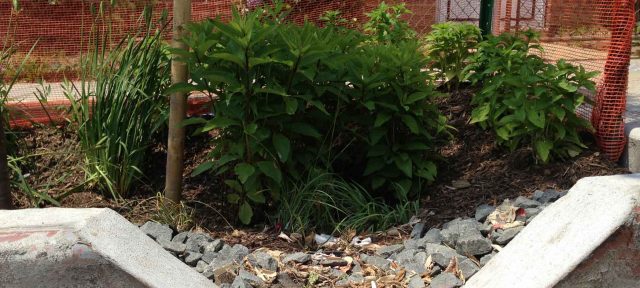Stormwater runoff is the source of a significant amount of heavy metal and nutrient pollution entering the waterways, especially in urban and suburban areas. With more paved road surfaces and buildings, rain flows over pavement, rooftops, and suburban lawns, collecting fertilizers and pesticides, heavy metals from traffic exhaust and industry, pet waste, and other forms of pollution. Green infrastructure is a low impact development option to build small bioswales or constructed wetlands to divert, filter, and clean stormwater runoff before it enters the waterways.
In addition to the problem of what stormwater runoff collects as it travels over urban built surfaces, rain can also give us problems with surface erosion. Especially in the desert southwest, it never rains, but it pours, as the old saying goes. When it rains, it really rains, and small communities and big cities go from drought to flash floods in moments. Communities need to find ways to collect and filter the water for later use and to prevent dangerous erosion and flash flooding.
Diversion canals are common in large urban centers with flash flood problems, but in smaller communities and rural areas, less infrastructure development can lead to alternative constructions, such as constructed bioswales and wetlands. Both of these options, when first proposed, turned out to be less successful than hoped for and anticipated. They washed out or failed, did not grow any plants, or otherwise needed refinement.
A bioswale in its simplest form is a depression in the ground that can collect water, and in the depression, plants grow. The roots filter out contaminated sediment that can impact fish spawning beds. The plants take up heavy metals and toxic waste and sequester the dangerous compounds in their leaves, preventing it from entering the waterways. The contaminated leaves are then treated as hazmat.
The problem with the early bioswales was they were not engineered for the force of water flow and the amount of water that moves during a flash flood. Proper engineering includes the infrastructure for water diversion and filtration using environmental textiles and pipes, the appropriate soil mixes for intermittent heavy water loads, and the proper plantings that can thrive in both feast or famine situations. Constructed wetlands are more complex. For an entirely new ecosystem to thrive, many moving parts have to work together. In all cases, however, the water coming into the bioswale or wetland needs to be filtered and cleaned before it leaves. A combination of environmental textiles that filter and divert water, and growing plants that can use their roots to take up pollutants, work better than either option alone.
Can we answer your questions about environmental textiles for bioswale construction? Please contact us for more information.

